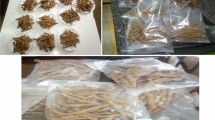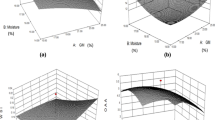Abstract
A study was conducted to optimize the mild extrusion cooking conditions for development of rice and chickpea based extrudates. The independent variables i.e. extrusion parameters (Screw speed, barrel temperature), feed moisture and proportions of rice flour and chickpea flour were varied using central composite rotatable design (CCRD), and their effects on system parameter- Specific mechanical energy (SME) and product characteristics i.e., water absorption index (WAI), water solubility index (WSI), bulk density (BD), expansion ratio (ER), breaking strength (BS), colour values (L*, a* and b*) and overall acceptability (OA) were studied. All the system and product responses were significantly affected by independent variables. Response surface and regression models were established to determine the responses as function of process variables. Models obtained were highly significant with high coefficient of determination (R2 ≥ 0.889). The optimum mild extrusion conditions obtained by numerical optimization for development of snacks were 102 °C barrel temperature, 281 rpm screw speed, 18.3% feed moisture and rice to chickpea flour ratio as 90:10. Storage studies confirmed that the developed snacks can be stored better in laminated pouches than in high density polyethylene (HDPE) bags for a period of 6 months under ambient conditions.

Similar content being viewed by others
References
Alam MS, Kaur J, Khaira H, Gupta K (2015) Extrusion and extruded products: changes in quality attributes as affected by extrusion process parameters: a review. Crit Rev Food Sci Nutr 56(3):445–473
Altan A, McCarthy KL, Maskan M (2008) Evaluation of snack foods from barley-tomato pomace blends by extrusion processing. J Food Eng 84:231–242
AOAC (2005) Official Methods of Analysis, 18th edn. Association of Official Analytical Chemists, Washington
Arhaliass A, Legrand J, Vauchel P, Fodil-Pacha F, Lamer T, Bouvier JM (2009) The effect of wheat and maize flours properties on the expansion mechanism during extrusion cooking. Food Bioproc Technol 2(2):186–193
Beigh M, Hussain SZ, Qadri T, Naseer B, Raja T, Naik H (2020) Investigation of process and product parameters for physico-chemical properties of low Glycemic Index water chestnut and barley flour-based extruded snacks. Br Food J 122(1):227–241
Bhattacharya S, Prakash M (1994) Extrusion of blends of rice and chick pea flours: a response surface analysis. J Food Eng 21(3):315–330
Brncic SR, Karlovic S, Zupan A, Herceg Z (2006) Evaluation of textural properties for whey enriched direct extruded and puffed corn based products. Bul J Agri Sci 15(3):204–214
Chakarborty P, Banerjee S (2009) Optimization of extrusion process for production of expanded product from green gram and rice by response surface methodology. J Sci Ind Res 68:140–148
Dalbhagat CG, Mahato DK, Mishra HN (2018) Effect of extrusion processing on physicochemical, functional and nutritional characteristics of rice and rice-based products: a review. Trends Food Sci Technol 85:226–240
De Pilli T, Derossi A, Talja RA, Jouppila K, Severini C (2011) Study of starch-lipid complexes in model system and real food produced using extrusion-cooking technology. Innova Food Sci Emer Technol 12:610–616
Devi ND, Shoba S, Tang X, Shaur SA, Dogan H, Alavi S (2012) Development of protein-rich sorghum based expanded snacks using extrusion technology. Int J Food Prop 16(2):263–276
Food Safety and Standards Act (2017) Rules 2011, Regulations, 17th Edition, 2017. International Law Book Company, India
Geetha R, Mishra HN, Srivastav PP (2014) Twin screw extrusion of kodo millet-chickpea blend: process parameter optimization, physicochemical and functional properties. J Food Sci Technol 51(11):3144–3153
Gropper M, Moraru C, Kokini J (2002) Effect of specific mechanical energy on properties of extruded protein-starch mixtures. Cereal Chem 79:429–433
Hagenimana A, Ding X, Fang T (2006) Evaluation of rice flour modified by extrusion cooking. J Cereal Sci 43:38–46
Hirdyani H (2014) Nutritional composition of chickpea (Cicer arietinum L.) and value added products. Indian J Commun Health 26(Suppl S2):102–106
Hussain SZ, Afshana B, Rather Ah (2015) Preparation and storage studies of walnut kernel incorporated rice-based snacks. Intl J Basic App Biol 2(6):449–451
Hussain SZ, Ali F, Jabeen R, Zargar I (2017) Twin screw extrusion cooking of lotus rhizome and broken rice flour blends: A response surface analysis. JSIR 76:485–493
ICMSF (2010) International Commission on Microbiological Specification for foods. USDA information office
Iwe MO, Van Zuilichem DJ, Ngoddy PO, Lammers W (2001) Amino acid and protein digestibility index of mixtures of extruded soy and sweet potato flours. Lebensm Wiss Technol 34:71–75
Kadan RS, Bryant RJ, Pepperman AB (2003) Functional properties of extruded rice flours. J Food Sci 68(5):1669–1672
Kaur B, Ranawana V, Henry J (2016) The glycemic index of rice and rice products: a review, and table of GI values. Critic Rev Food Sci Nutr 56(2):215–236
Kaur N, Singh B, Sharma S (2018) Storage stability of extruded normal maize and quality protein maize based extruded products. Int J Pure App Biosci 6(4):42–47
Khan MA, Semwal AD, Sharma GK et al (2011) Development and evaluation of long shelf-life ambient stable chapattis without the use of chemical preservatives. J Food Process Technol 2:107–111
Lim S (2018) Eating a balanced diet: a healthy life through a balanced diet in the age of longevity. J Obes Metab Syndrome 27(1):39
Meng XD, Threinen D, Hansen M, Driedger D (2010) Effects of extrusion conditions on system parameters and physical properties of a chickpea flour-based snack. Food Res Int 43:650–658
Mesquita CDB, Leonel M, Mischan MM (2013) Effects of processing on physical properties of extruded snacks with blends of sour cassava starch and flaxseed flour. Food Sci Technol 33(3):404–410
Mulla MZ, Bharadwaj VR, Annapure US, Singhal RS (2011) Effect of formulation and processing parameters on acrylamide formation: a case study on extrusion of blends of potato flour and semolina. LWT Food Sci Technol 44:1643–1648
Nakhon PPS, Jangchud K, Jangchud A, Charunuch C (2018) Optimization of pumpkin and feed moisture content to produce healthy pumpkin-germinated brown rice extruded snacks. Agric Nats Res 52:550–556
Nithya DJ, Basco KA, Saravanan M, Mohan RJ, Alagusundaram K (2016) Optimization of process variables for extrusion of Rice-Bengal gram blends. JSIR 75:108–114
Pardhi SD, Singh B, Nayik GA, Dar BN (2016) Evaluation of functional properties of extruded Snacks developed from brown rice grits by using response surface methodology. J Sau Soc Agric 18(1):7–16
Ruskova M, Bakalov I, Petrova T, Zsivanovits G, Ivanova K, Penov N (2015) Effect of extrusion variables on breaking strength of bean-based extrudates; presented in International Scientific- Practical Conference “Food Technologies And Health”. Agricultural Academy, At Bulgaria, Plodiv
Sacchetti G, Pinnavaia GG, Guidolin E, Dalla-Rosa M (2004) Effects of extrusion temperature and feed composition on the functional, physical and sensory properties of chestnut and rice flour-based snack-like products. Food Res Int 37:527–534
Sandrin R, Caon T, Wüst-Zibetti A, de Francisco A (2017) Effect of extrusion temperature and screw speed on properties of oat and rice flour extrudates. J Sci Food Agric 98:10
Serna-Saldivar SO, Rooney LW (1995) Structure and chemistry of sorghum and millets. In: Dendy DAV (ed) Sorghum and Millets: Chemistry and Technology. AACC, St. Paul, MN, pp 69–124
Seth D, Rajamanickam G (2012) Original article development of extruded snacks using soy, sorghum, millet and rice blend—a response surface methodology approach. Int J Food Sci Technol 47(7):1526–1531
Sharma C, Singh B, Hussain SZ, Sharma S (2017) Investigation of process and product parameters for physicochemical properties of rice and mung bean (Vigna radiata) flour based extruded snacks. J Food Sci Technol 54(6):1711–1720
Shirani G, Ganesharanee R (2009) Extruded products with fenugreek (Trigonella foenum-graecium) chickpea and rice: physical properties, sensory acceptability and glycaemic index. J Food Eng 90:44–52
Singh B, Sekhon KS, Singh N (2007a) Effects of moisture, temperature and level of pea grits on extrusion behaviour and product characteristics of rice. Food Chem 100:198–202
Singh S, Gamlath S, Wakeling L (2007b) Nutritional aspects of food extrusion: a review. Int J Food Sci Technol 42:916–929
Singh B, Rachna Hussain SZ, Sharma S (2015) Response surface analysis and process optimization of twin screw extrusion cooking of potato-based snacks. J Food Proc Preserv 39:270–281
Wani SA, Kumar P (2016) Fenugreek enriched extruded product: optimization of ingredients using response surface methodology. Int Food Res J 23(1):18–25
Yagci S, Gogus F (2009) Selected physical properties of expanded extrudates from the blends of hazelnut flour-durum clear flour-rice. Int J Food Prop 12(2):405–413
Yovchev A, Stone A, Hood-Niefer S, Nickerson M (2017) Influence of the extrusion parameters on the physical properties of chickpea and barley extrudates. Food Sci Biotechnol 26(2):393–399
Yu L, Ramaswamy HS, Boye J (2012) Twin-screw extrusion of corn flour and soy protein isolate (spi) blends: a response surface analysis. Food Bioprocess Technol 5:485–497
Author information
Authors and Affiliations
Corresponding author
Additional information
Publisher's Note
Springer Nature remains neutral with regard to jurisdictional claims in published maps and institutional affiliations.
Rights and permissions
About this article
Cite this article
Altaf, U., Hussain, S.Z., Qadri, T. et al. Investigation on mild extrusion cooking for development of snacks using rice and chickpea flour blends. J Food Sci Technol 58, 1143–1155 (2021). https://doi.org/10.1007/s13197-020-04628-7
Revised:
Accepted:
Published:
Issue Date:
DOI: https://doi.org/10.1007/s13197-020-04628-7




